Family : Orchidaceae

Text © Prof. Pietro Pavone

English translation by Mario Beltramini
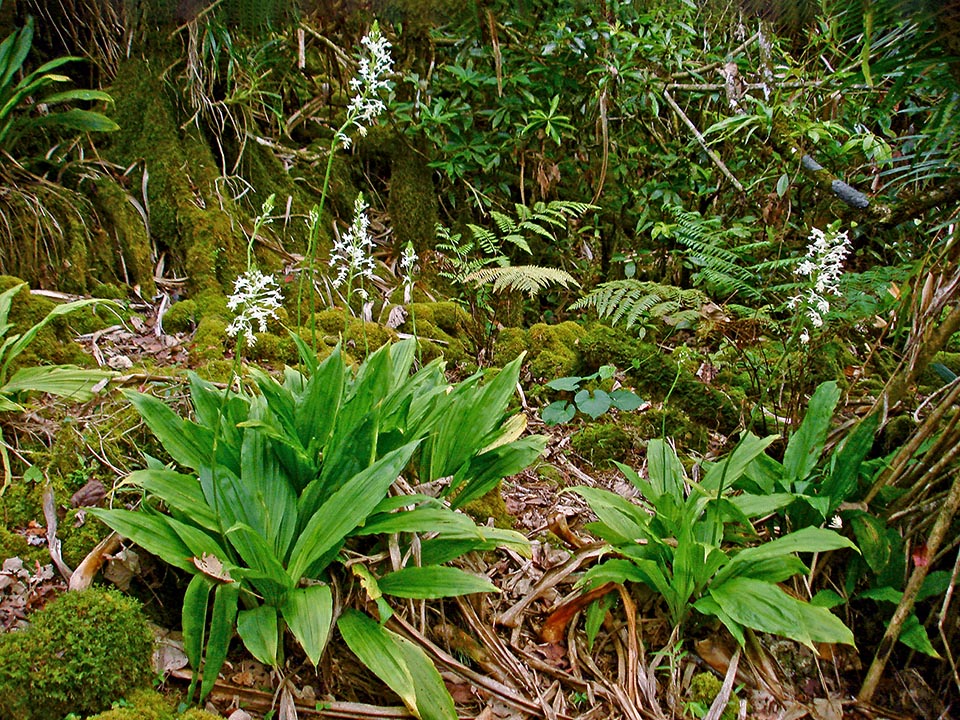
Calanthe triplicata is an amply diffused species, native to the rainforests of Oceania, of Asia, and of the islands of eastern Africa © Lauren Gutierrez
Calanthe triplicata (Willemet) Ames (1907) belongs to the family Orchidaceae, subfamily Epidendroideae, tribe Collabieae.
It is a species with an ample diffusion native to Oceania, Asia and the islands of eastern Africa.
It has been found in Mauritius, Madagascar, Seychelles, Assam, eastern Himalaya, southern India, Sri Lanka, Myanmar, Thailand, Malaysia, Laos, Cambodia, southern China, Vietnam, Borneo, Java, Sunda Lesser Islands, the Moluccas, Philippines, Sulawesi, Sumatra, Bismarck Islands, New Guinea, Solomon Islands, Australia, Fiji, New Caledonia, Samoa, Vanuatu, Wallis and Futuna, Marquesas Islands, Santa Cruz Islands, Carolines, Marianas, Taiwan, Ryukyu Islands. In Australia it is found between the Iron Range in Queensland and the Illawarra in New South Wales, and in Norfolk and Lord Howe islands.
Christmas lily grows on the soil of the deciduous rainforest, near water streams, in the crevasses of limestone rocks, on the humid and shady lands rich in humus, at altitudes ranging from 500 (700) to 1500 (2400) metres above the sea level.
The roots of Calanthe triplicata do not go deep into the soil but remain among the decaying leaves and on other forest debris present also on rocks and decaying trunks.
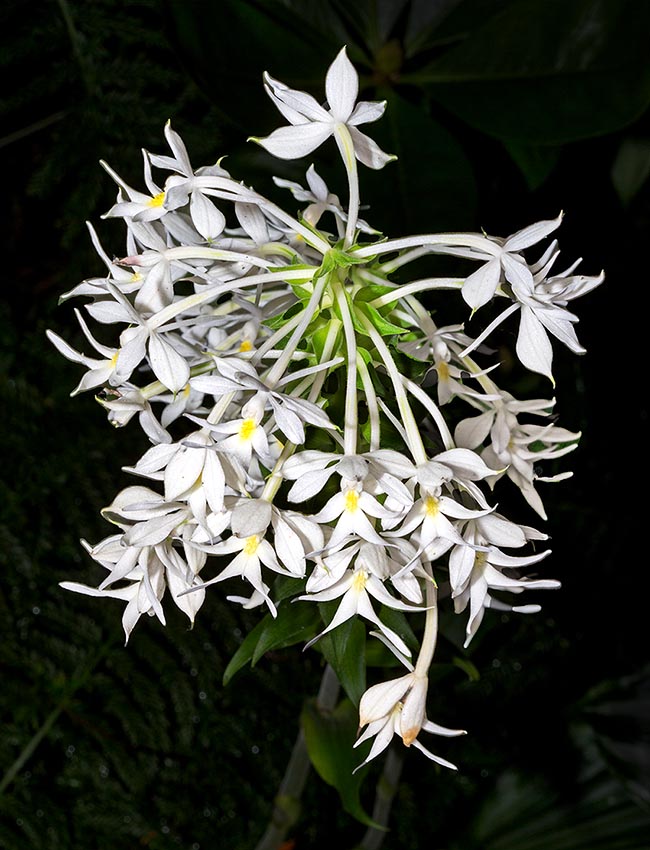
The rich inflorescence on an up 20 cm long raceme, bears 18-40 white flowers, about 5 cm broad © Giuseppe Mazza
This species was formally for the first time in 1796 by the French botanist Pierre Rémi Willemet (1735-1807) who published the description in the Neue Annalen der Botanik, Paul Usteri 18:54 assigning the name of Orchis triplicata.
The name was changed in Calanthe veritifolia in 1823 by the Scottish botanist Robert Brown (1773-1858), great traveller who collected in Australia more than 3400 species, of which about 2000 new for the Science.
In 1907, the American botanist Oakes Ames (1874-1950) who has identified and studied the orchids of Florida, the Caribbean, of Philippines and of central and southern America, after a careful examination of the samples of herbarium specimens of the rich collection present in the Philippine Bureau of Science, realized that the name, assigned by Brown, was based on the good species Calanthe furcata described by Lindley.
However, the latter had been described assuming as valid character the difference of the lateral lobes of the labellum and of the forked point spur that, conversely, are not a valid character, being variable in several specimens.
In accordance with that, the name given by Brown did not deem it valid. Ames therefore restored the specific epithet of Willemet and now the accepted name for this species is Calanthe triplicata (Willemet) Ames.
The name of the genus Calanthe comes from the Greek “καλός” (kalos) meaning ‘beautiful’ and “ἄνθος” (anthos) ‘flower’ with reference to the attractiveness of its flowers.
The specific epithet comes from the Latin prefix tris meaning ‘three times’ and plicatus that means ‘folded’, due to the three lobes of the labellum. It is commonly known as Christmas lily, Common Christmas orchid, Thrice folded Calanthe, San Zhe Xia Ji Lan in China.
Calanthe triplicata is a 40-100 cm tall perennial plant with small ovoid-cylindrical pseudobulbs, mainly hidden by the leaves, 40-80 mm long and 20-40 mm broad, with prominent veins, wrapped by 2 or 3 sheaths.
From the pseudobulbs originate the 2 or more (6-10 ) leaves, evergreen, completely developed during the blooming, with 20-60 cm long and 5-17 cm brod lamina, elliptical or elliptical-lanceolate, sharp, little hairy in the upper paginaand pubescent in the lower one. They have almost parallel veins in number of 6 or more (9). The petiole is 6,5 (10)-18 (25) cm long. The inflorescences get formed in correspondence with the leaf axils. The are 4-20 cm long racemes, erect and pubescent with several flowers, 18 to 40, with persistent bracts, partly curved.
The flowers, of about 5 cm of diametre, are white. The ovary with the pedicel is 29-60 mm long, pubescent. The sepals are elliptical, of 10-18 x 3-9 mm, pubescent. The lateral ones at times are slightly longer than the median sepal. The petals, oblong to oblanceolate, measure 8,5-15 x 3,5-7,7 mm. The labellum is trilobate, 14-23 x 7-24 mm, with the base united to the column and similar to a Cross of Lorraine. The three lobes are 4-15 mm long and 2-6 mm broad; the central lobe is further divided in two. At the base of the labellum, above, stands an excrescence (callus) of yellow, orange or red colour.
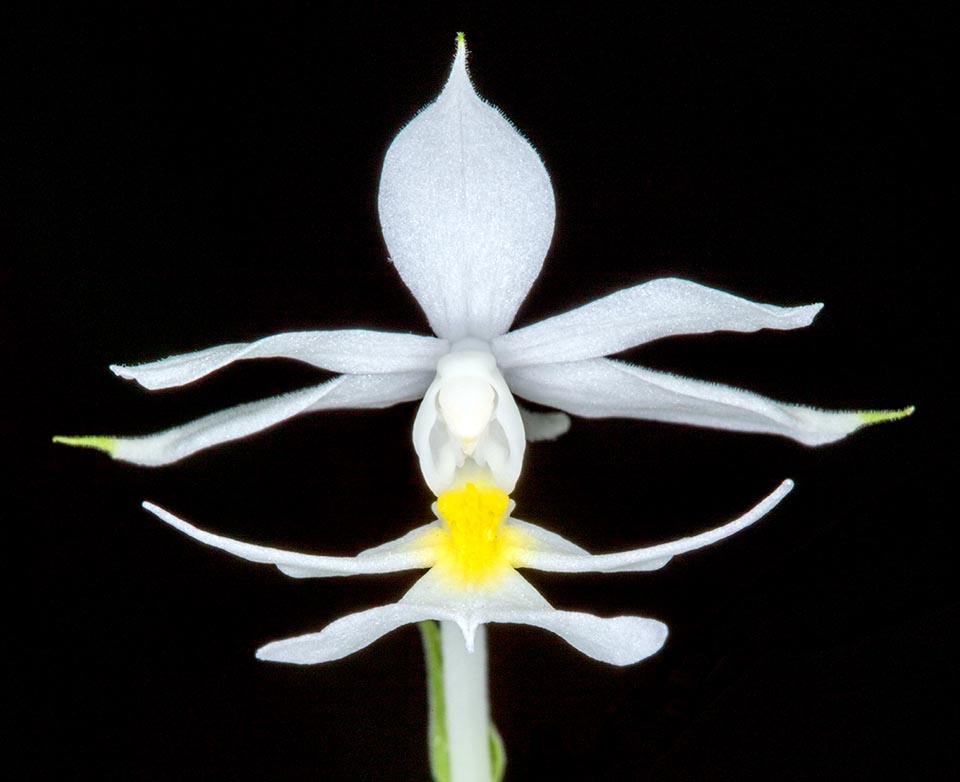
Close-up of flower, with the base united to the column, similar to a Cross of Lorraine. Above the labellum base stands a yellow, orange or red outgrowth © Giuseppe Mazza
The spur is cylindrical, 10-30 mm long, pubescent and curved. The column is 4-7 mm long, scarcely pubescent. The fruit is an ellipsoidal capsule, 25-35 x 8-15 mm, pubescent. The flowering occurs from October to February in Australia and in April and May in China. The flowers last about 3-4 weeks and open one after the other.
Yore, in Sumatra, the flowers of Christmas lily were utilized as painkillers. In New Caledonia the plant was utilized against gastrointestinal disorders. In India the flowers are employed as analgesics whilst the roots and the rhizomes are chewed to treat diarrhoea and applied on the hands to reduce swelling.
Calanthe triplicata is a very ornamental orchid easy to cultivate. There are hybrids of it with labellum with a nice intense pink colour. The plants are resistant to direct sun but do prefer the shade. Therefore, they are to be placed where the light of the sun is filtered until mid-morning, remaining in full shade for the rest of the day. They are to be kept sheltered if the temperatures drop below 15 °C.
Calanthe triplicata can be cultivated in gardens in well drained zones, always maintained humid during the periods of maximum drought. It is also possible to cultivate it in an apartment in a fairly large pot in order to give the plant the possibility of expanding. It grows quite well on loam specific for the orchids formed by blond peat and bark with addition of well decayed leaves. Cow manure can even be added without exceeding in order to avoid the production of many leaves to the detriment of flowers.
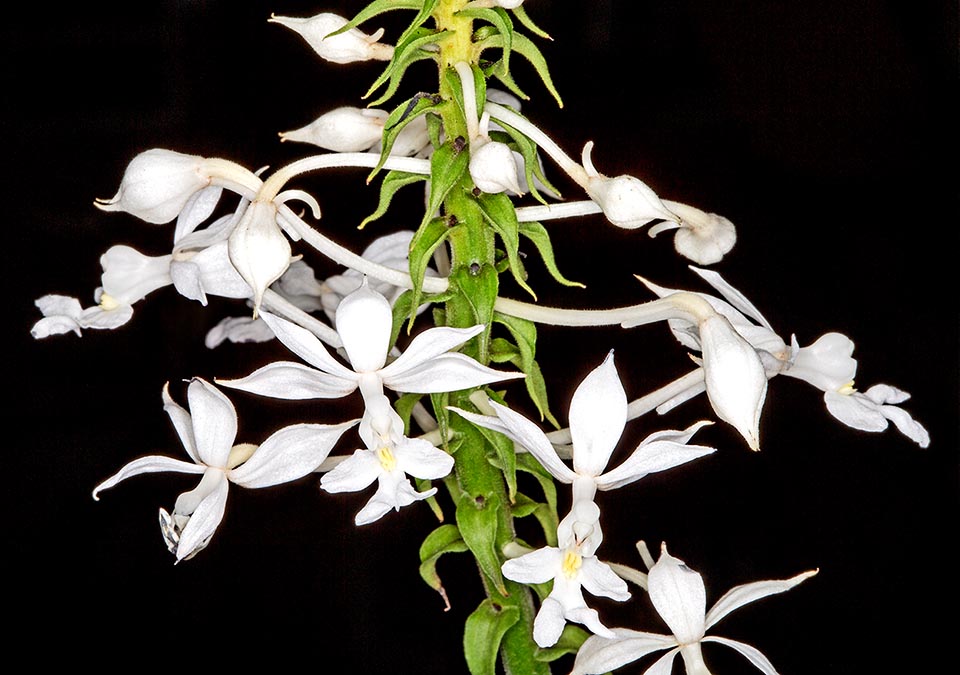
Yore flowers were used for gastrointestinal disorders and as painkillers. Roots and rhizomes were chewn to treat diarrhoea and a mix of them, applied on hands, reduced their swelling. Now Calanthe triplicata is appreciated as ornamental orchid easy to cultivate also in the garden, with minimum temperatures over the 15 °C, or at home © Giuseppe Mazza
The Christmas lily, being native to climates with abundant rainfalls all over the year, requires daily nebulizations. In order to hinder the growth of fungi a good ventilation is recommended, but not an exposure to drafts.
To give plenty of water, especially during the summer months and after the flowering, to avoid that the soil dries up completely.
The multiplication of these plants occurs by seeds and, more easily, vegetatively. In fact, in spring, after blooming, the pseudobulbs may be divided and repotted. To do this, separate the oldest pseudobulbs from the plant, put them in a mix of slightly humid loam and wait for the new buds to appear at the base of the pseudobulbs.
The plants of Calanthe are sensitive to mites. The infested plants must be treated with an insecticide.
Also the cochineals may attack these plants. Usually they hide under the dried leaves, on the pseudobulbs and at the base of the cut floral peduncles. It is good practice to physically remove the adult cochineals and control the immature stages with an appropriate insecticide. Also, be careful of snails. These gastropods can be eliminated by using a suitable molluscicide or by manual collection during regular inspections.
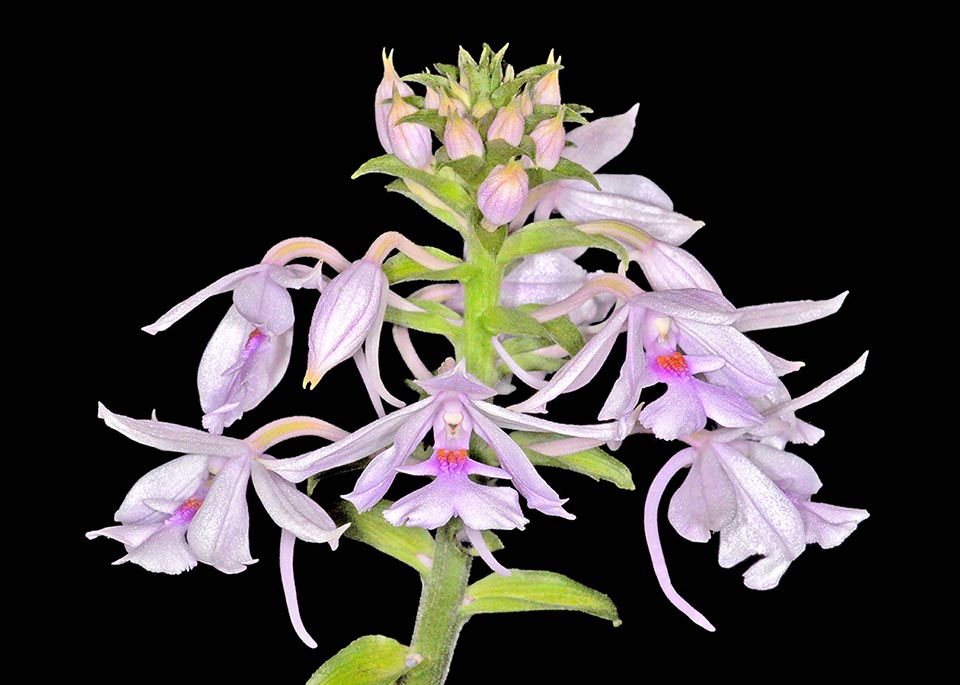
Calanthe × dominyi Lindl is a natural hybrid of Calanthe masuca x Calanthe triplicata © Masaki Asuka-Ron Parsons
Synonyms: Alismorkis angraeciflora (Rchb.f.) Kuntze (1891); Alismorkis diploxiphion (Hook.f.) Kuntze (1891); Alismorkis furcata (Bateman ex Lindl.) Kuntze (1891); Alismorkis gracillima (Lindl.) Kuntze (1891); Alismorkis veratrifolia Kuntze (1891); Amblyglottis veratrifolia Blume (1825); Calanthe anchorifera Rchb.f. (1883); Calanthe angraeciflora Rchb.f. (1876); Calanthe anthropophora Ridl. (1915); Calanthe australasica D.L.Jones & M.A.Clem. (2006); Calanthe bracteosa Rchb.f. (1882); Calanthe brevicolumna Hayata (1911); Calanthe breviflos Ridl. (1925); Calanthe catilligera Rchb.f. (1857); Calanthe colorans Rchb.f. (1885); Calanthe diploxiphion Hook.f. (1890); Calanthe furcata Bateman ex Lindl. (1838); Calanthe furcata ‘Albolineata’ K.Nakaj. (1969); Calanthe furcata ‘Albomarginata’ K.Nakaj. (1969); Calanthe furcata ‘Brevicolumna’ (Hayata) M.Hiroe (1971); Calanthe gracillima Lindl. (1855); Calanthe matsumurana Schltr. (1906); Calanthe muelleri Kraenzl. (1893); Calanthe nephroglossa Schltr. (1911); Calanthe orthocentron Schltr. (1912); Calanthe petri Rchb.f. (1880); Calanthe proboscidea Rchb.f. (1884); Calanthe pubescens Ridl. (1923); Calanthe rubicallosa Masam. (1975); Calanthe triantherifera Nadeaud (1873); Calanthe triplicata ‘Albolineata’ (K.Nakaj.) Hatus. (1971); Calanthe triplicata ‘Albomarginata’ (K.Nakaj.) K.Nakaj. (1973); Calanthe triplicata var. angraeciflora (Rchb.f.) N.Hallé (1977); Calanthe triplicata var. minahassae Schltr. (1925); Calanthe triplicata var. gracillima (Lindl.) N.Hallé (1998); Calanthe triplicata ‘Purpureoflora’ S.S.Ying (1990); Calanthe veratrifolia var. cleistogama Schltr. (1912); Calanthe veratrifolia var. lilacina Hassk. (1907); Calanthe veratrifolia var. timorensis J.J.Sm. (1934); Calanthe veratrifolia var. stenochila Rchb.f. (1857); Calanthe veratrifolia var. kennyi F.M.Bailey (1912); Calanthe veratrifolia var. dupliciloba J.J.Sm. (1922); Calanthe veratrifolia var. australis Linden (1851); Calanthe veratrifolia R.Br. ex Ker Gawl. (1823); Limodorum ventricosum Steud. (1821); Limodorum veratrifolium Willd. (1805); Orchis triplicata Willemet (1796).
